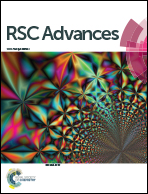Label-free electrochemical detection of DNA methyltransferase activity via a DNA tetrahedron-structured probe†
Abstract
Recently, 3-dimensional DNA nanostructures have gained significant attention due to their programmable folding nature. Herein, a DNA tetrahedron-structured probe (DTP) is designed for the detection of methyltransferase (MTase) activity based on HRP-mimicking DNAzyme triggered deposition of polyaniline (PANI). In this strategy, MTase activity is measured with differential plus voltammetry (DPV) using PANI as the redox label. Furthermore, the DNA tetrahedron controlled the nanospacing between capture DNA, which greatly improves hybridization efficiency, MTase combination capability, and detection sensitivity. Using this method, more than 5 times higher signal gain is achieved compared with a single-strand capture DNA probe (ssP) without the tetrahedron structure. Under optimized experimental conditions, the DPV intensity is in linear correlation with M.SssI concentration ranging from 0.05 to 10 U mL−1, with a correlation coefficient of 0.9936 and a detection limit of 0.03 U mL−1 (S/N = 3). The inhibition of 5-Aza-z′-deoxycytidine or procaine on M.SssI activity is also evaluated. Good accuracy, precision and sensitivity are obtained when the method is applied in complex matrixes such as human serum samples, which is significant for clinical diagnosis and drug development.


 Please wait while we load your content...
Please wait while we load your content...